There are several different types and severity of Colour Blindness. Thus, it is of core significance to identify correctly the exact problem area for each individual case before starting treatment for the same.
And this is exactly when India’s most elaborate colour blindness testing facility and one of the best in the world exhibits its sophisticated superiority in preciseness over all else. Our comprehensive testing comprises of several well-known colour blindness tests from world over, as well tests developed by Dr. K.K. Goyal and Dr. Suman Goyal themselves; these tests have been developed on the basis of their years of learnings from being in this field and extensive, path-breaking R&D from their end.
We have every internationally known colour blindness tests in our clinic right from the basic Ishihara to the latest in technology i.e the CAD (Colour Assessment and Diagnosis) test. Thus we provide a very detailed and comprehensive report for precise diagnosis of colour vision deficiency in every patient.
Below is the brief description of the various tests we perform at Sanjeevan clinic.

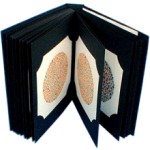 The test consists of a number of coloured plates, called Ishihara plates, each of which contains a circle of dots appearing randomized in colour and size. The full test consists of 38 plates, but the existence of a deficiency is usually clear after a few plates.
The test consists of a number of coloured plates, called Ishihara plates, each of which contains a circle of dots appearing randomized in colour and size. The full test consists of 38 plates, but the existence of a deficiency is usually clear after a few plates.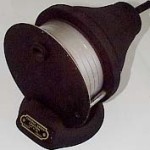 The ‘Edridge Green Lantern’ Test displays a single light with colour filters in rotating discs that can be modified to simulate conditions of weather and atmosphere. This test for colour blindness was officially adopted in Great Britain in 1915 in place of the Holmgren wool test.
The ‘Edridge Green Lantern’ Test displays a single light with colour filters in rotating discs that can be modified to simulate conditions of weather and atmosphere. This test for colour blindness was officially adopted in Great Britain in 1915 in place of the Holmgren wool test.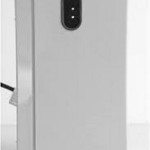 Lantern tests for colour blindness simulate signal lights and are used most commonly by professions requiring the accurate interpretation of signals, flags or other coloured stimuli. The Farnsworth lantern or FALANT is the standard test used in the US.
Lantern tests for colour blindness simulate signal lights and are used most commonly by professions requiring the accurate interpretation of signals, flags or other coloured stimuli. The Farnsworth lantern or FALANT is the standard test used in the US.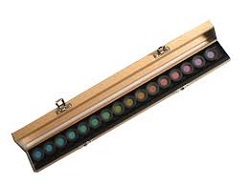 The Farnsworth D-15 Test is an abridged version of the 100 Hue Test for screening colour vision defects only. The D-15 Test is intended for the detection of colour vision defects such as red-green and blue-yellow deficiencies as opposed to colour acuity. The test consists of a reference cap and 15 removable chips of incremental hue variation.
The Farnsworth D-15 Test is an abridged version of the 100 Hue Test for screening colour vision defects only. The D-15 Test is intended for the detection of colour vision defects such as red-green and blue-yellow deficiencies as opposed to colour acuity. The test consists of a reference cap and 15 removable chips of incremental hue variation.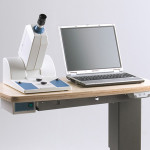 The ‘HMC Anomaloscope’ is a microprocessor-controlled device for precision diagnosis of colour vision in the red/green area (Rayleigh equation) and in the blue/green area (Moreland equation) with integrated automatic neutral adaptation.
The ‘HMC Anomaloscope’ is a microprocessor-controlled device for precision diagnosis of colour vision in the red/green area (Rayleigh equation) and in the blue/green area (Moreland equation) with integrated automatic neutral adaptation.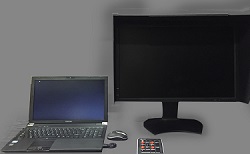 This highly sensitive test is a gold standard in colour deficiency testing. It is the first and the only machine in India, amongst the very few in the world. It is a primary requisite to pass the CAD test to be certified by the JAA (Joint Aviation Authority) – Europe and also many other Government and Private agencies around the world.
This highly sensitive test is a gold standard in colour deficiency testing. It is the first and the only machine in India, amongst the very few in the world. It is a primary requisite to pass the CAD test to be certified by the JAA (Joint Aviation Authority) – Europe and also many other Government and Private agencies around the world.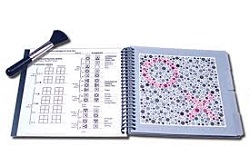 Charts for testing colour vision on which are printed dots of various colours, brightness, saturation and sizes, arranged so that the dots of similar colour form a geometrical shape among a background of dots of another colour. The colours of the figure and the background correspond to the confusion colours of the various types of anomalous colour vision.
Charts for testing colour vision on which are printed dots of various colours, brightness, saturation and sizes, arranged so that the dots of similar colour form a geometrical shape among a background of dots of another colour. The colours of the figure and the background correspond to the confusion colours of the various types of anomalous colour vision.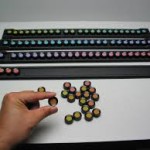 The ‘Farnsworth 100 Hue Test’ tests the ability to isolate and arrange minute differences in various colour targets with constant value and chroma that cover all the visual hues described by the Munsell colour system.
The ‘Farnsworth 100 Hue Test’ tests the ability to isolate and arrange minute differences in various colour targets with constant value and chroma that cover all the visual hues described by the Munsell colour system.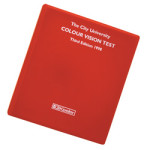 This test is derived from the well-known D15 colour arrangement test and is based on different plates, where out of four dots the one which comes closest to a fifth dot has to be selected. This test allows the identification of the type and approximate severity of colour blindness.
This test is derived from the well-known D15 colour arrangement test and is based on different plates, where out of four dots the one which comes closest to a fifth dot has to be selected. This test allows the identification of the type and approximate severity of colour blindness.